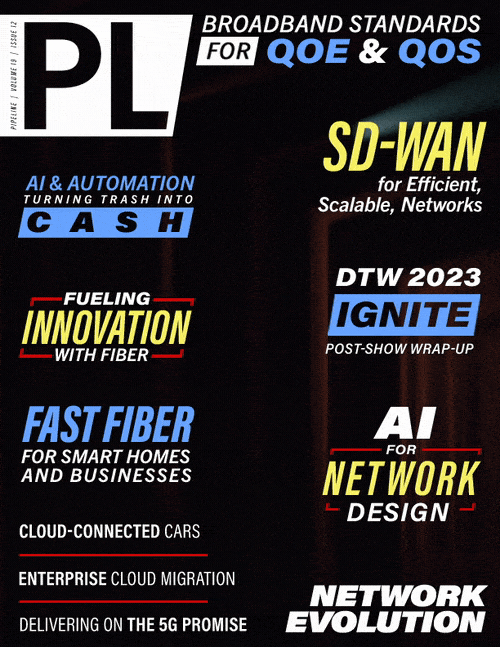Letter from the Editor

If you’re fortunate enough to live in the modern world, connectivity underpins almost every moment of your day. You may use your mobile phone as an alarm clock, and to check the weather or news as you head out the door. You might even warm up your car using your voice assistant or the app provided by the vehicle manufacturer. You may also check the car infotainment system for traffic updates and route information as you cruise through over-the-road tolling sites on highways with dynamically adjusting speed limits to ease the flow of traffic. And that’s all before 9AM.
Once you reach the office, you’re likely confronted with a barrage of connected devices and inundated with data. Emails, alarms, and alerts from various systems and applications proliferate on your monitor, phone, and smartwatch. These are all intended to make you more productive, more efficient, and better at your job, while relying on a range of networks and connectivity of their own. Meanwhile, your smart vacuum is hard at work at home, sweeping up the coffee grounds you spilled on the floor as you rushed out of the house, and your doorbell camera is keeping a watchful eye on your porch for package deliveries. That night, you may order grocery delivery online, transfer money using your mobile device and banking app, stream your favorite movie, talk to your family and friends over an app using voice-over-IP, before starting the whole thing over again the next day.
And that’s just a ho-hum, daily routine. Today you can have remote surgery or run an entire assembly plant that hinges on robotics and mission-critical, low-latency connectivity—or operate a smart farm that relies on low-power IoT networks. But one thing is for certain, this insatiable demand for connectivity and bandwidth isn’t slowing, and it’s rife with cost and complexity—particularly for the Communication Service Providers (CSPs) that make it all possible.
In many cases, the CSPs are taken for granted. They are the unsung heroes, ushering in the new digital world. Customers just want their services to work, however, and don’t care about cost or complexity. The end users leave the solving up to the industry: the standards bodies, industry associations, technology providers, and yes, the CSPs. But this is no easy task. Just to make the routine scenario described above possible, the technologies being leveraged are astounding—including 5G, Wi-Fi, RF, Lidar, Bluetooth, Ethernet, and GPS, just to name a few. And each underlying technology comes with its unique considerations, parameters, limitations, integration standards, and evolution.
During your morning commute alone, your vehicle and mobile devices are being seamlessly handed off from tower to tower, and data is being aggregated and analyzed in real-time while it’s being passed off at the speed of light over fiber optics. And that’s not to mention the AI, cybersecurity, or analytics systems that are running in the background at the same time. As you zip carefree down the highway, these networks and systems are all working in concert to provide you with a seamless and secure experience. Truly remarkable when you think about it.
On the other hand, if you are part of the 37 percent of the world’s population that is offline and not part of a modern society—there’s a blueprint in place to fundamentally transform life as you know it. You can rest assured knowing that the industry is hard at work in developing countries to close the digital divide to provide access to the world’s banking systems, lifesaving medicine, and commerce. All of which makes this edition so important.
In this issue of Pipeline, we explore the evolution of today’s networks. Pipeline’s man on the beat reports from DTW – Ignite 2023 in Copenhagen where the industry came together to tackle some of the world’s most pressing communication-technology challenges. The Broadband Forum tells us how service-led industry standards are improving QoE and QoS. CerebrumX explores in-vehicle edge processing for cloud-connected cars and data monetization strategies. Airgain considers using C-band frequencies to deliver on the promise of 5G. Aryaka analyzes the evolution of SD-WAN for efficient, scalable, and secure networks. Spirent shows us how AI is being used for advanced network design and testing to meet today’s demands for quality connectivity. Assurant explains how CSPs can lock in value and improve customer retention with AI for refurbishing and repairing mobile devices. Cross Town Fiber discusses how investments in AI and fiber-optic infrastructure are unlocking innovation. Fiber Fast Homes delves into how the demand for high-speed connectivity is driving fiber adoption for smart homes and businesses, and Nitel examines how enterprises can ease the migration to cloud to enhance productivity. All this, plus the latest enterprise and telecom technology news, and more.
We hope you enjoy this and every issue of Pipeline.
Scott St. John
Managing Editor
Pipeline
Follow on Twitter | Follow on LinkedIn | Follow Pipeline



















